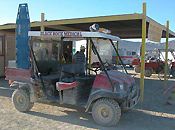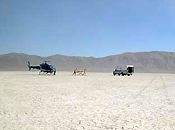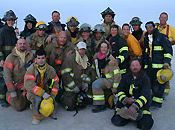Emergency Services Department
For information on the history and development of the ESD, please refer to the ESD Afterburn reports from previous years.
HIGHLIGHTS
Emergency Messages
The public ESD email address 911@burningman.com has become an increasingly common way for the general public to pass emergency messages to staff and participants. While delivery can’t be guaranteed due to rapid changes in the Black Rock City environment, it does offer a way for family and loved ones to try to reach participants. The effort in 2005 to monitor, respond, and attempt to deliver messages was a solid first attempt to create an effective resource for urgent communications into Black Rock City. Messages were given to Playa Info for availability to people who might be expecting emergency messages. Participants don’t necessarily camp in expected locations, and they sometimes spend a lot of time in other camps, or their camps are hidden by the explosive growth of Black Rock City, so finding people on the playa can be a very difficult task without precise information on how to find their camps. Without these specifics, messages rarely reach their intended recipients, unless those people go to Playa Info looking for the message. Plans for 2006 include improved communication about how to send an emergency message with adequate information to make delivery more feasible.
Missing Persons
ESD implemented a new missing person resource in 2004, creating a huge learning curve for all involved departments. The program was intended to combine information from ESD, the Regional Emergency Medical Services Authority (REMSA) ambulances, Rangers, and law enforcement to create a single point of information at Playa Info about participants transported to Reno hospitals, arrested by law enforcement, or evicted by the Rangers. By placing all of this information at a single location, friends and loved ones have a place to go when someone they know seems to have disappeared. Lessons learned in earlier years made the 2005 program a success. For 2006, an even higher success rate will result from additional improvements to insure higher compliance with the process.
ESD Volunteer Mobilization
The ESD Planning Section took on the task in 2005 of centralizing the ESD volunteer check in and check out process. All uniforms, radios, and documentation were distributed from a single location. Scheduling and other important information were made available there as well to allow this resource to function as a clearinghouse for information vital to arriving volunteers. This function is a standard feature of ICS and its implementation shows that ESD has advanced in organizational complexity and capacity.
Regionals
For the first time in 2005, ESD officially provided consulting assistance, support, and volunteer recruitment efforts for regional events in need of medical, fire, or mental health professionals. Plans for 2006 include increased direct involvement with the Regional Representatives and the Regionals council.
Decompression and Burning Man Special Events
Plans for 2006 include increased ESD support of Burning Man organized special events, such as Decompression and the Fire Fest. This support will focus on safety planning, staffing of medical and fire resources, and strategic planning regarding relations with local governments and permitting.
BRANCHES OF SERVICE
Medical Services
 The Emergency Medical Services (EMS) branch of ESD works closely with REMSA and the Fire Branch to provide a municipal style EMS system much like those in most other cities in the United States. Personnel from the Medical and Fire Branch staff two 24-hour stations at the 3 and 9 o’clock plazas to provide rapid first-response medical care anywhere within Black Rock City. Each station houses a quick-response vehicle (QRV) dedicated to EMS work for operations within the unified ESD concept. An ESD fire engine and mini-engine also reside at each station. The Mini’s are cross-staffed by one fire fighter and one medic, so these engines can also function in a first-responder EMS role and provide additional support on hazardous material, technical, and rescue incidents.
The Emergency Medical Services (EMS) branch of ESD works closely with REMSA and the Fire Branch to provide a municipal style EMS system much like those in most other cities in the United States. Personnel from the Medical and Fire Branch staff two 24-hour stations at the 3 and 9 o’clock plazas to provide rapid first-response medical care anywhere within Black Rock City. Each station houses a quick-response vehicle (QRV) dedicated to EMS work for operations within the unified ESD concept. An ESD fire engine and mini-engine also reside at each station. The Mini’s are cross-staffed by one fire fighter and one medic, so these engines can also function in a first-responder EMS role and provide additional support on hazardous material, technical, and rescue incidents.
REMSA provides advanced life-support ambulance service within Black Rock City, helps staff the Center Camp clinic, and handles all ground and air transportation to Reno hospitals. REMSA and the ESD Medical Branch are fully integrated operationally during the event.
Complaints increased in 2004 about REMSA’s customer service and bedside manner. In response to that feedback, ESD and REMSA set out to address this issue in 2005. The effort included improved training for REMSA’s medical staff, a strong commitment from REMSA’s mangers to work on the issue, and available feedback forms on-playa, resulting in a positive effect in reducing the number and severity of complaints received in 2005. The number of complaints received dropped by 90%, and participants provided more positive feedback than in any other year for both ESD and REMSA. Questions, additional feedback, or concerns regarding REMSA or ESD performance, professionalism, or patient care can be directed to 911@burningman.com.
After the 2004 event, the ePlaya bulletin board turned into a valuable feedback mechanism when a discussion thread about crutches emerged. At that time, neither ESD or REMSA provided patients with crutches, a service that community feedback suggested would have been helpful to people who had sustained moderate injuries to their legs. The community discussion turned up a great idea for a crutch drive to solicit used crutch donations. Requests via email and the Jackrabbit Speaks newsletter resulted in a significant number of donations. Many people used crutches for a couple of days and then returned them so that others in need could use them. At the end of the event, ESD had amassed a large cache of crutches that had been donated, issued, and finally returned for use in 2006. Plans for the future include requesting additional community donations to ensure the continued success of this program. If you wish to donate, simply bring your old crutches to the event and drop them off at any medical station.
Medical Statistics
 ESD and REMSA together logged approximately 3,260 patient contacts in 2005 (up 20% from 2004) with a peak combined patient volume of 590 patients seen on Saturday, September 3. Of the total patient contacts, 368 involved 911-style responses within Black Rock City (up 42% from 2004) facilitated via REMSA ambulance, ESD QRV, or other ESD first responder resources. That number is equivalent to one EMS response every 39 minutes during the event and the weekend before it. Since total patient volume increased only 20% since last year it is postulated that the increase in transports is due to an increased awareness of ESD’s and REMSA’s available services.
ESD and REMSA together logged approximately 3,260 patient contacts in 2005 (up 20% from 2004) with a peak combined patient volume of 590 patients seen on Saturday, September 3. Of the total patient contacts, 368 involved 911-style responses within Black Rock City (up 42% from 2004) facilitated via REMSA ambulance, ESD QRV, or other ESD first responder resources. That number is equivalent to one EMS response every 39 minutes during the event and the weekend before it. Since total patient volume increased only 20% since last year it is postulated that the increase in transports is due to an increased awareness of ESD’s and REMSA’s available services.
Approximately 54% of the total patient volume involved minor injuries such as blisters and minor lacerations. Common patient categories included eye problems (9% of total patients), heat-related injuries (11% of total patients), and patient follow-up (13% of total patients). The remaining 13% of the total patient volume comprised of all other medical categories, including abdominal pain, burns, difficulty breathing, and urinary tract infections (each representing roughly 2% of the remaining 13%). The statistics for drug and alcohol related patients have remained stable for the last 3 years averaging only 20 alcohol-related and 32 drug-related patients per year, regardless of total patient volume or city population. Of the 40 patients transported to Reno hospitals for additional care in 2005, 26 were stable patients transported by ground ambulance and 14 were flown out by helicopter.
The 2005 event was marked by the tragic deaths of two men, both of whom died of cardiac arrest in separate incidents. One was declared dead on playa after a concerted effort to save the man’s life. It was later determined by the coroner that he died of natural causes. The second cardiac arrest initially survived due to the hard work and dedication of the emergency medical providers who rushed to his aid; sadly he later slipped into a coma in the hospital and died in late October.
Communications
The ESD Communications Branch provides the Emergency Services dispatch center and establishes the on-playa communications infrastructure for the entire Burning Man organization. The dispatch center functions as a fully staffed, 24-hour, public safety answering point. It operates as a Unified Command Post coordinating all emergency responses within Black Rock City for the ESD and allied agencies, such as REMSA, the Bureau of Land Management (BLM), and law enforcement. The continual flow of information between BLM, law enforcement, and the ESD dispatch center allowed all of the event’s public safety agencies to provide improved service and safety to participants. Similarly, all other Burning Man departments depend on reliable two-way communications to make the event happen.
The ESD communications infrastructure provides the means for this function. Utilizing a network of two-way radio repeaters both on-site and at remote locations, the Communications Branch ensures that the system has fail-safe and redundant technologies in order to cope with the harsh conditions of the Black Rock Desert. This critical precaution supports all functions of the Burning Man Project, because any department that loses its ability to communicate loses its ability to do its job. A hardy team of about 10 engineers and technicians work year-round to ensure the integrity of the system. These engineers perform hundreds of hours of work before the event and hundreds more on-site every year to make sure the communications system functions as designed.
For year-round communications for the Department of Public Works (DPW) and other staff use, the Communications Branch maintains a series of radio towers. Since cell phones don’t work in the area, the towers are essential both to enable work to happen in an effective manner and for safety of the staff in the event of incidents such as vehicle breakdowns or injuries. Plans for 2006 call for construction of a new 100-foot tower on the Black Rock Station property to replace the 60-foot tower currently in place. The higher tower and more modern equipment (installed in the summer of 2005) will allow for better communications over the ridge where Solider Meadows road bisects the Hualapai and Black Rock playas. Additionally, ESD expects to install an additional repeater on a high peak in the area to provide better wide-area coverage sometime before 2010.
Finally, updates to the custom-built alphanumeric paging software and computer-aided dispatch system provided a solid 2.0 release. Integrated into this new system is the capacity for remote paging terminals and the ability to page from a web interface directly to a pager on playa. This innovation allowed for staff in San Francisco, Gerlach, and Black Rock City to send pages directly from their own computers with a secure log in. Emergency dispatchers could then focus on urgent issues while the Gate, Box Office, and other staff could independently page as needed. All departments who utilized this new feature reported this resource to be an invaluable convenience, and ESD plans on expanding this system in 2006 with additional features.
Mental Health
The Mental Health Branch (MHB) consists of 17 highly trained and dedicated psychiatric and mental health professionals. The MHB responds to needs for psychiatric services on the playa, performs crisis intervention for sexual assault and domestic violence victims, and provides victim advocacy to local agencies, such as law enforcement and local hospitals. The Branch responded to a high number of critical incidents in 2003 by forming a separate team to perform several mental health support functions. This Mental Health Support team is designated to respond to any significant event in direct support of the on-duty MHB teams, much like many county mental health resources would respond to a school shooting or other tragic event.
All MHB team members carry pagers and are on call even when off-duty in case of a critical incident or unexpectedly high call volume. During duty shifts they work in pairs on a 24-hour on-call basis. During the peak of the event a minimum of two teams are available at all times to ensure service to participants who are in need.
Mental Health Statistics
The Mental Health Branch responded to approximately 32 calls in 2005, which is a slight increase in the average total calls for service from previous years. Most MHB calls take at least several hours to resolve, so just a few calls in a 24-hour shift constitute a very busy caseload. Full-team activations and responses to sexual assaults are especially time-consuming, and they tend to last at least 4 hours or more and involve multiple follow-up visits.
MHB cases in 2005 include 12 psychiatric clients, 5 domestic-violence related cases, 7 sexual assault cases, and 8 other calls for service or follow-up. The Mental Health Support team was not needed for deployment to any critical events in 2005.
For more information on joining either the Mental Health Branch or the Mental Health Support Team, email 911@burningman.com.
Fire Service
 The ESD Fire Branch works to keep Black Rock City safe from fires that could endanger life and property. Equally importantly, the Fire Branch is one of the key elements in making art burns safe and enjoyable experiences for participants. The Fire Branch interfaces and cooperates with the Art Department, the Performance Safety team (PST), the pyrotechnics team, the event’s supporting fire vendors, and the Rangers. The Fire Branch also plays the key role of providing safety planning and Rapid Intervention teams (RITs) during planned performance burns.
The ESD Fire Branch works to keep Black Rock City safe from fires that could endanger life and property. Equally importantly, the Fire Branch is one of the key elements in making art burns safe and enjoyable experiences for participants. The Fire Branch interfaces and cooperates with the Art Department, the Performance Safety team (PST), the pyrotechnics team, the event’s supporting fire vendors, and the Rangers. The Fire Branch also plays the key role of providing safety planning and Rapid Intervention teams (RITs) during planned performance burns.
The Fire Branch and two fire-suppression vendors — Julie’s Water Tenders and Lightning Suppressors — collectively provide fire engines and fire fighters to three 24-hour fire stations in Black Rock City. Despite the central role that fire plays in the event, fire-related emergencies requiring ESD responses remain infrequent.
Eight pieces of fire-fighting apparatus stand on duty 24 hours a day in Black Rock City. Five engines are managed and staffed by ESD, and the last three are managed and staffed by vendors. All function seamlessly in the ESD command structure, and ESD is recognized as the leading authority on fire-suppression and tactics within Black Rock City. Additionally, a small hazardous materials cleanup unit remains available to handle fuel spills and similar problems.
The 2005 event resulted in only 24 fire-related calls for service, and no major fires were reported.
Submitted by:
Joseph Pred
Contributors: David Barr, Fire Branch Deputy Chief, Planning
Anna Duffy, Mental Health Branch Chief
Tracy McDowell, Medical Branch, Administrative Chief
Dave Spencer, Communications Branch Deputy Operations Chief

